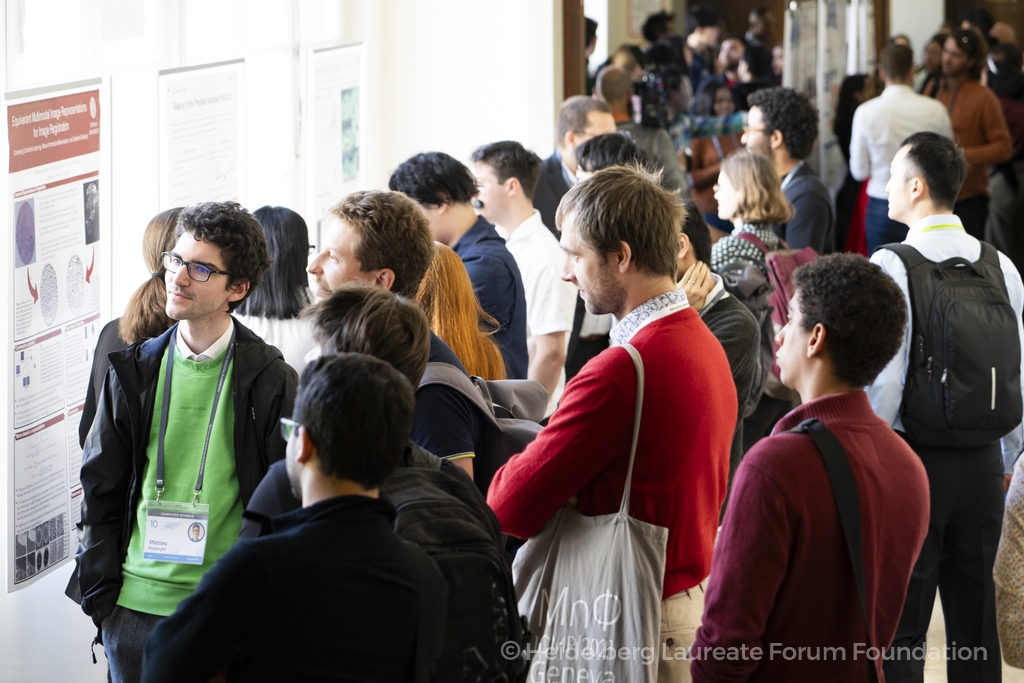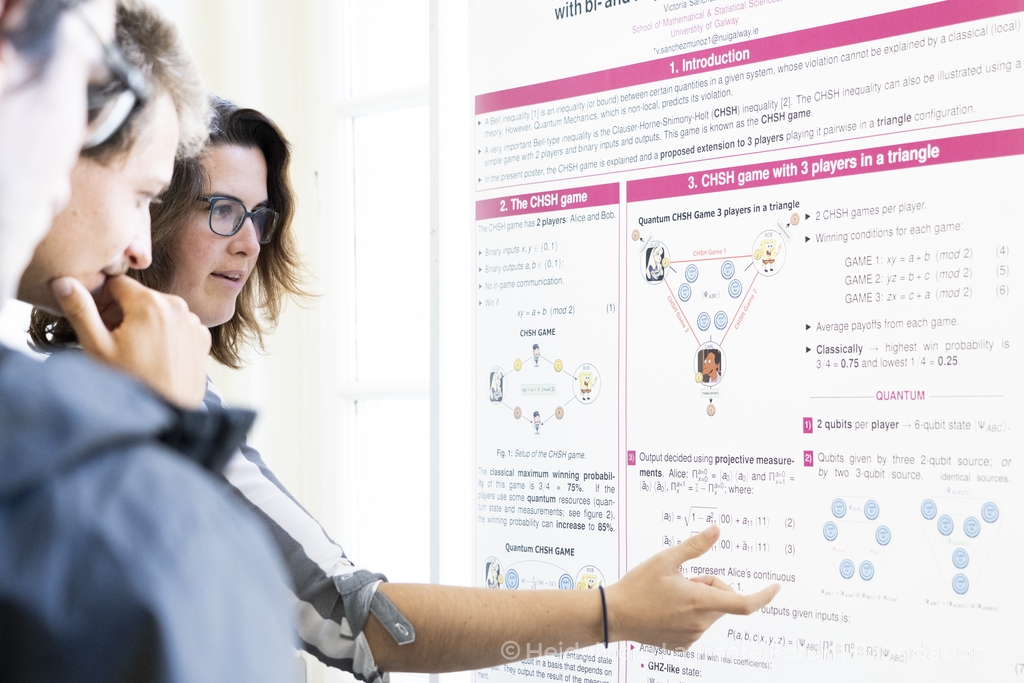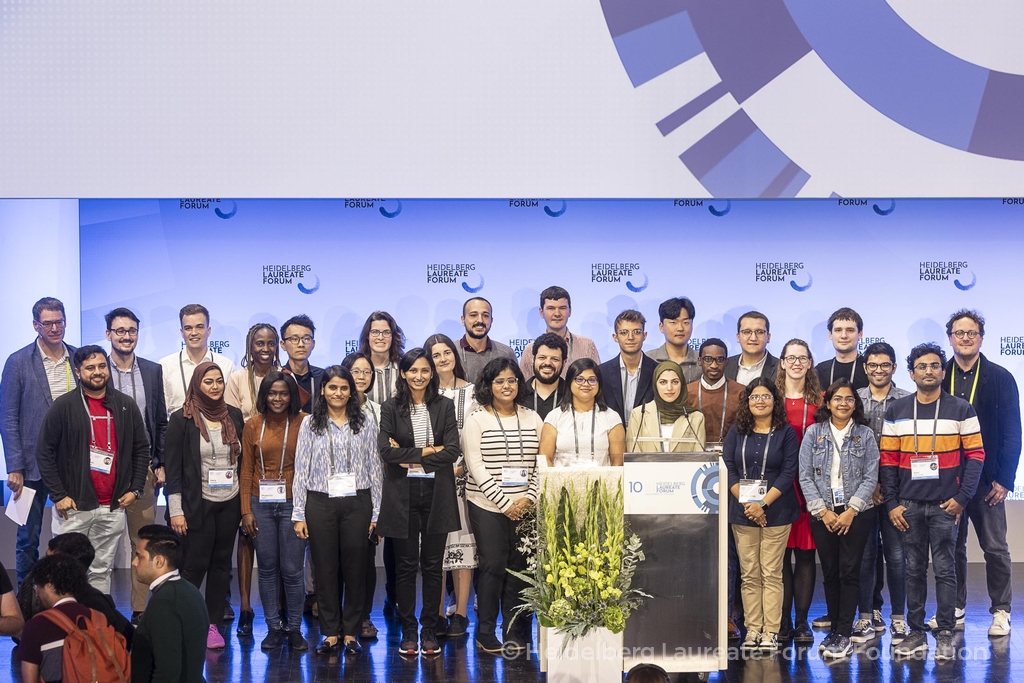Posters of Progress: All Eyes on the Young Researchers Taking the Stage
Andrei Mihai
While the laureates are the main attraction of the Heidelberg Laureate Forum (HLF), the young researchers are the heart and soul of the event. It is only fitting that during the first day of this year’s 10th HLF, young researchers took to the stage to present some of their own work.
From Ishika Ghosh, who described her use of complex topology to unravel the secrets of tree leaf shapes, to Yasra Chandio who delved into the rapidly evolving field of mixed reality (merging the tactile, physical world with intricate computer-generated elements), young researchers got a few minutes to explain their specialized work and try to convey its broader relevance. The session was followed by a poster session in which the audience was invited to visit the posters and discuss them in more detail.
Presentations ranged from pure mathematics to applied computer science and everything in between and there was no shortage of intriguing topics. Using mathematics and computer science was a common thread between presentations, but pure science was also given center stage.
A Whirlwind of Intellectual Curiosity
What do snakes, jellyfish, and astronauts have in common? You could say that they are all fascinating creatures and all interesting in their own way, but Oliver Karl Klaus Gross sees something else. They all use specific sequences of poses in order to generate motion, Gross mentions. He models motion with the help of the fiber bundle of positioned shapes. There is a geometric formulation of this phenomenon, which he used to show that in many scenarios, physical motion is actually a horizontal lift. Modeling motion is an important emerging area of research with applications in different fields. In robotics, for instance, motion modeling helps in planning and controlling movements. Robots rely on accurate motion models to perform tasks like picking up objects, moving around, and even performing surgeries. Plus, you get to model an armadillo springboard diving, which is an excellent perk.
As if drawing inspiration from Gross’ mathematical models of motion, Sascha Robert Gaudlitz dove into the equally fascinating world of complex mathematical equations. Gaudlitz gave a mini-masterclass on communicating mathematics. He works on what is arguably one of the most challenging aspects in mathematics: modeling complex, stochastic, spatiotemporal phenomena with partial differential equations. How does one present that in a couple minutes? Well, “think of them as being a mathematical recipe,” the young researcher explained. With any kind of recipe, you have the ingredients you work with and the cooking techniques that you need to follow. His work is somewhat akin to that, except you start from the meal and see whether you can infer the ingredients and cooking procedures just by tasting it. After all, who said mathematics is not delicious?
Solving Tangible Problems
Science is not necessarily always practical. Nevertheless, it is just fantastic when it improves something about our society. Several young researchers focused exactly on that.
For instance, Mohak Chada works on sustainable computing. If you think this is not a problem, you should probably know that data centers already consume over 1% of global energy and are projected to consume 8-13% of global energy by 2030. That means that if data centers were a country, they would rank the top 10 energy consumers. So making this type of computing more sustainable is essential for our transition to a sustainable future. This is one of the reasons Chada is working on something called GreenCourier.
GreenCourier takes a new cloud computing approach called serverless computing. In serverless computing, users are only responsible for writing small pieces of code called functions while all infrastructure management is handled by the cloud service provider. This reduces carbon emissions through an intelligent scheduling policy that schedules serverless functions depending on their carbon-efficiency. Chada found that this approach can significantly reduce carbon emissions for data centers.
Life science and healthcare also took the stage. Catherine Chen works on how the human brain represents semantic information from different languages. She found that the cortical representation of lexical semantics is shared between English and Chinese. This is somewhat surprising, because if you look at clinical or behavioral data, you get contrasting evidence regarding how semantics is processed in different languages. Chen and her colleagues gave participants some stories to listen to and then carried out fMRI scans of their brains. From that, they developed computational models to compare brain representations of lexical semantics, finding a common cortical representation across these different languages.

Laura Margaret Stegner worked on something else: robots; specifically, care robots. Many countries are facing an aging population and there is a growing need for assisted care. At the same time, the work force in this field is steadily decreasing in many countries. Can robots be of assistance? If so, how do we integrate robots into these complex and delicate ecosystems? These are the questions Stegner is working on. She conducted design studies to understand each stakeholders’ need and envision what systems are necessary to successfully integrate robots into existing workflows and habits. She found that the system needs to support quick, on-the-fly inputs because caregivers often have hectic and dynamic schedules. At the same time, the robots should support simple, natural inputs to encourage the assisted adults to use it. Because the care environment and the necessity can change rapidly, the robot must also exhibit context awareness and potentially even modify the originally specified task. These are not simple tasks, but Stegner believes that end-user development (EUD) could be a tool to aid these tasks, personalizing care robots’ behaviors and actions. These tools use a combination of AI and formal methods and could help alleviate a very real problem.
Today’s Young Researchers Are Already Making a Difference
As the session moved downstairs for the poster discussion, one thing was abundantly clear: The young researchers present are not just the future – they are the ‘now’. They are tackling complex questions that span across disciplines, from pure mathematics and environmental sustainability to healthcare and human cognition. They are pushing the boundaries of what is known and, perhaps more importantly, challenging the ways we approach these problems.
Their projects have demonstrated how impactful interdisciplinary research can be, but also how important it is to have a solid theoretical foundation.
As they take their research from the halls of the Heidelberg Laureate Forum into the wider world, we can only wait in eager anticipation for the breakthroughs that are sure to come.
The post Posters of Progress: All Eyes on the Young Researchers Taking the Stage originally appeared on the HLFF SciLogs blog.

